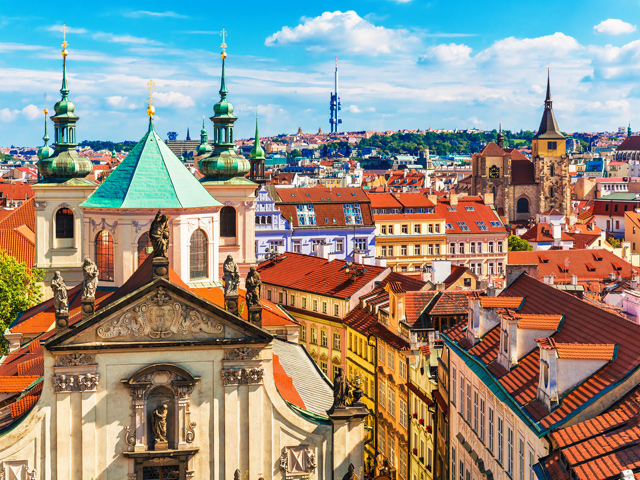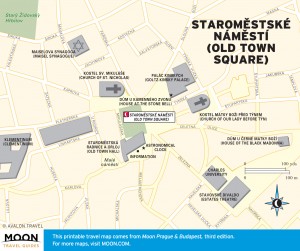
Old Town architecture in Prague. Photo © scanrail/123rf.

Staroměstské Náměstí (Old Town Square)
For most people, entering Old Town Square for the first time is like walking onto a movie set in the 18th century, when colorful facades and architectural styles ranging from Gothic to baroque were par for the course. Not only is it the country’s most beautiful square, it is undoubtedly one of the entire continent’s as well. It has operated as Prague’s economic and political center since the 10th century, acting as marketplace, execution site, and location of nation-changing announcements—including the beginning of the Communist takeover. While its first houses date as far back as the 12th and 13th centuries, the square remains home to some of the city’s most spectacular buildings, including Old Town Hall with its famous Astronomical Clock, St. Nicholas Church, and the Church of Our Lady Before Týn.The ever-growing number of visitors who flock to the city has changed the face of the square, fueling an overt commercialism that includes a line of stalls on the west side selling kitsch to the swarms of tour groups that descend on the square daily. Despite the crowds, it is still one of the most wondrous places in town—a space often filled with smiling faces, people posing for photographs, swing jazz bands, and lovers enjoying the romance in the air, which is as old as it is intoxicating. Cafés, bars, and restaurants have got in on the act, too, setting out tables and chairs that offer the finest views available. Throughout the summer, the square is often the site of world-music concerts, art exhibits, and a wide variety of traditional cultural events. In the winter, it is the setting of Prague’s biggest Christmas market, a jolly outdoor affair augmented by a gigantic brilliantly lit tree.
The center of the square is characterized by the Jan Hus monument, dedicated to the Protestant reformer who was labeled a heretic and burned at the stake on July 6, 1415. It was designed by Ladislav Šaloun and presented to the public in 1915 on the 500th anniversary of Hus’s death. The base of its steps used to be a popular meeting point as well as a perfect place for locals and visitors alike to take a breather and drink in the square’s charm. Unfortunately, countless overzealous (and drunken) tourists repeatedly tried climbing the monument, prompting authorities to install a ring of flowerbeds and benches around it.
Near the monument lies a brass strip in the ground known as the Prague Meridian, which marks the site of the former Marian Column of 1650. When the column’s shadow fell on the meridian at noon, a senior timekeeper in the observation tower of the Klementinum would wave a flag, prompting all of Prague’s timekeepers to synchronize their clocks.
Excerpted from the Third Edition of Moon Prague & Budapest.